Understanding the Role of Shallow Groundwater in Improving Field Water Productivity in Arid Areas
Abstract
:1. Introduction
2. Materials and Methods
2.1. Experiments
2.2. Data
2.3. Model Description
2.3.1. Modified Agricultural Water Productivity Model for Shallow Groundwater
2.3.2. Crop Module Considering Soil Salinity
2.3.3. Description of Soil Module Considering Soil Salinity
2.3.4. Actual Evapotranspiration Module Considering Soil Salinity
2.4. Model Calibration and Validation
2.4.1. Sensitivity Analysis of Parameters
2.4.2. Uncertainty Analysis of Parameters
2.5. Scenarios for Evaluation of Water Use and Yield
3. Results
3.1. Evaluation of the Modified AWPM-SG
3.1.1. Soil Moisture: Calibration and Validation
3.1.2. Soil Salinity: Calibration and Validation
3.1.3. Groundwater Table: Calibration and Validation
3.1.4. Crop Leaf Area Index (LAI): Calibration and Validation
3.1.5. Parameter Sensitivity and Uncertainty Analysis
3.2. Effect of Salinity in Groundwater on Crop Water Use and Yield
3.2.1. Groundwater Recharge on soil Water in Root Zone
3.2.2. Soil Salt Content in Actual Root Zone
3.2.3. Crop Evapotranspiration
3.2.4. Maize Yield
3.2.5. Water Productivity and Irrigation Water Productivity
4. Discussion
4.1. Contribution of Groundwater Recharge on Crop Water Use
4.2. Relationship between WP, IWP and Groundwater Salinity, Groundwater Depth
5. Conclusions
Author Contributions
Funding
Acknowledgments
Conflicts of Interest
Appendix A
A.1. Modified AWPM-SG Model Overview
A.1.1. Description of Crop Module-EPIC Considering Soil Salinity
Phonological Development
Potential Growth
A.1.2. Leaf Area Index
A.1.3. Effect of Environmental Stress on Biomass Growth
A.1.4. Root Growth
A.1.5. Crop Yield and Water Productivity
A.2. Description of Soil Module-WIPE Considering Soil Salinity
A.2.1. Soil Water Flow
A.2.2. Water Balance Calculation of Zone 2:
A.2.3. Soil Salt Transport
A.3. Description of Actual Evapotranspiration Considering Soil Salinity
Appendix B
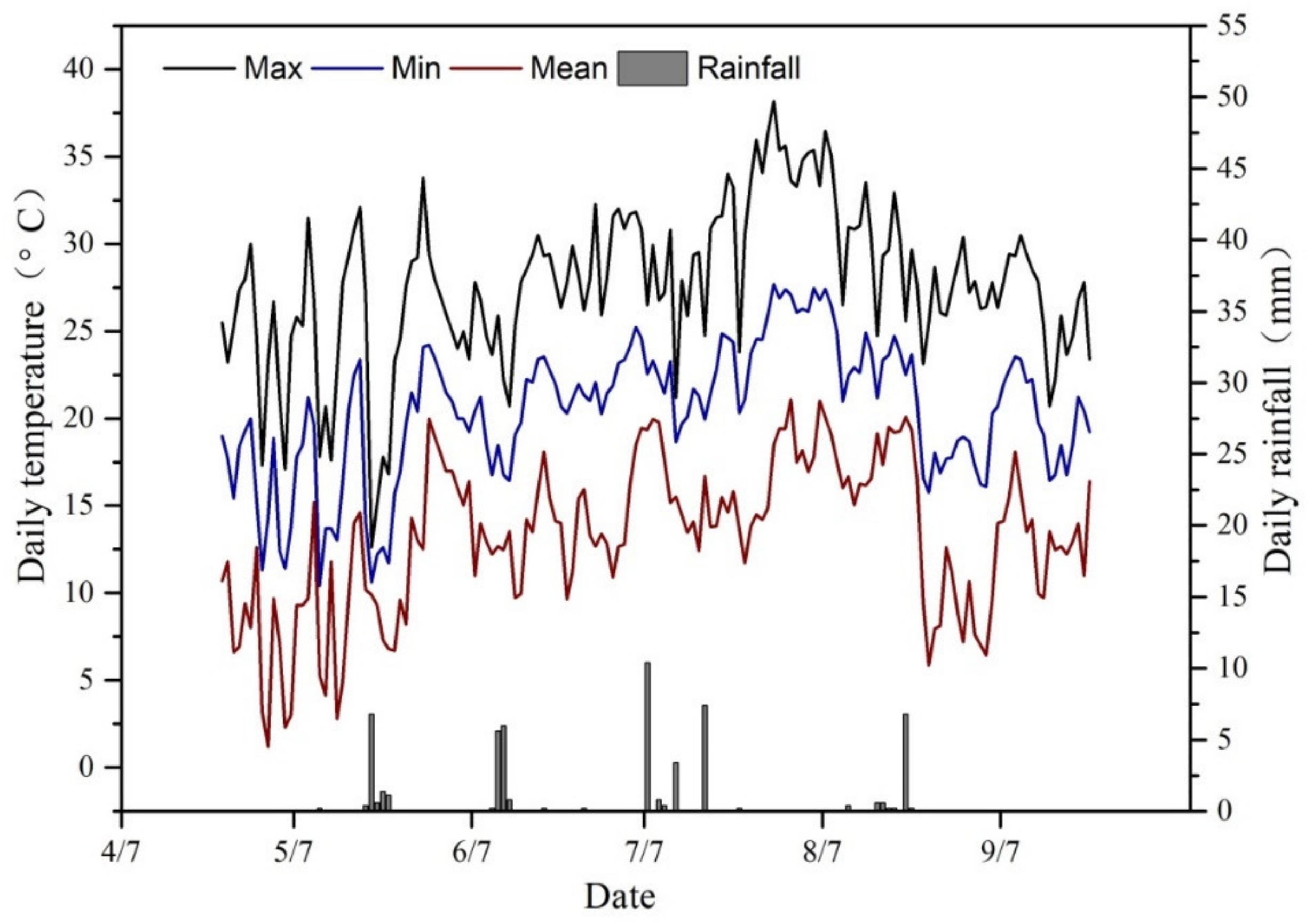

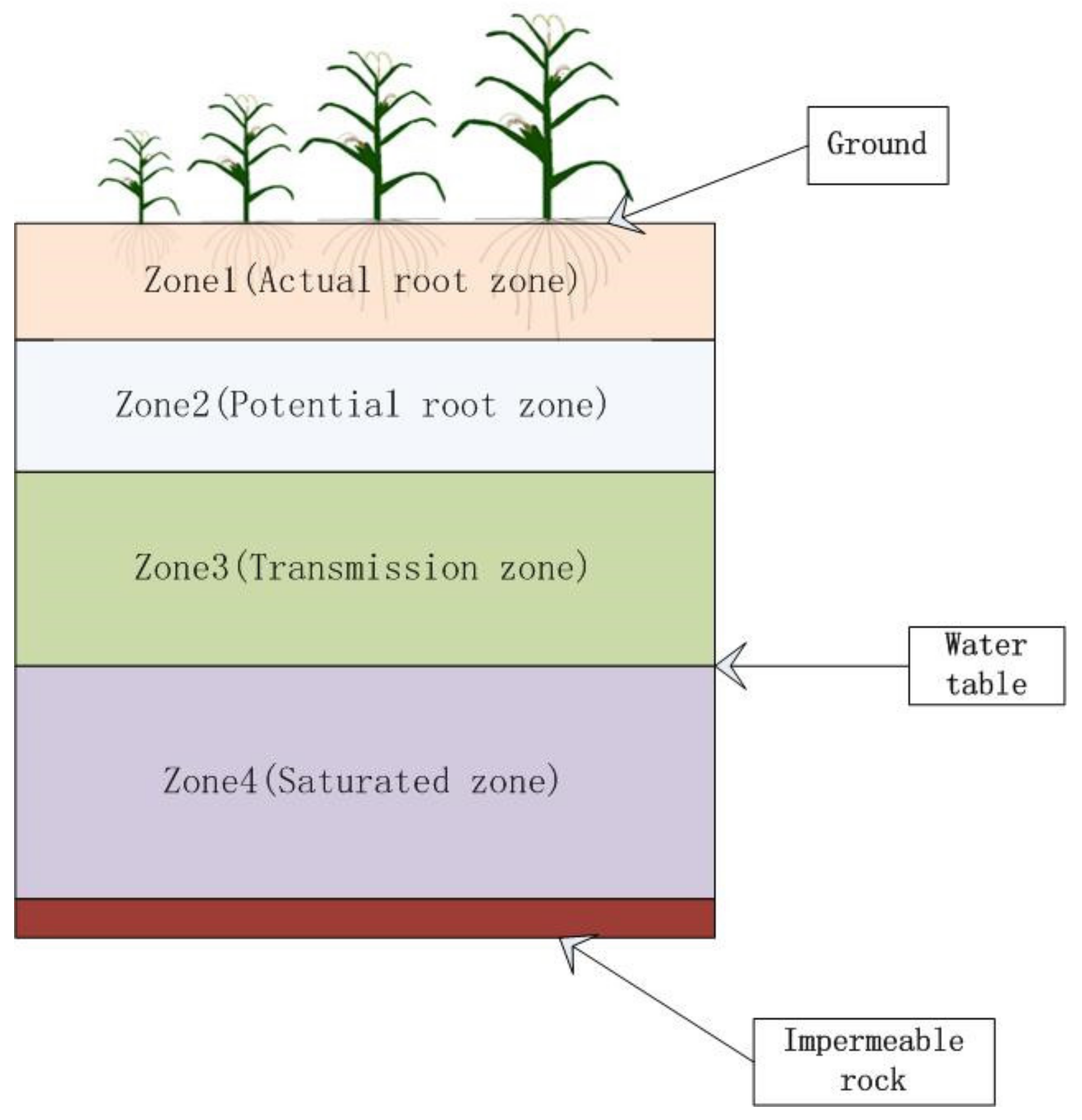
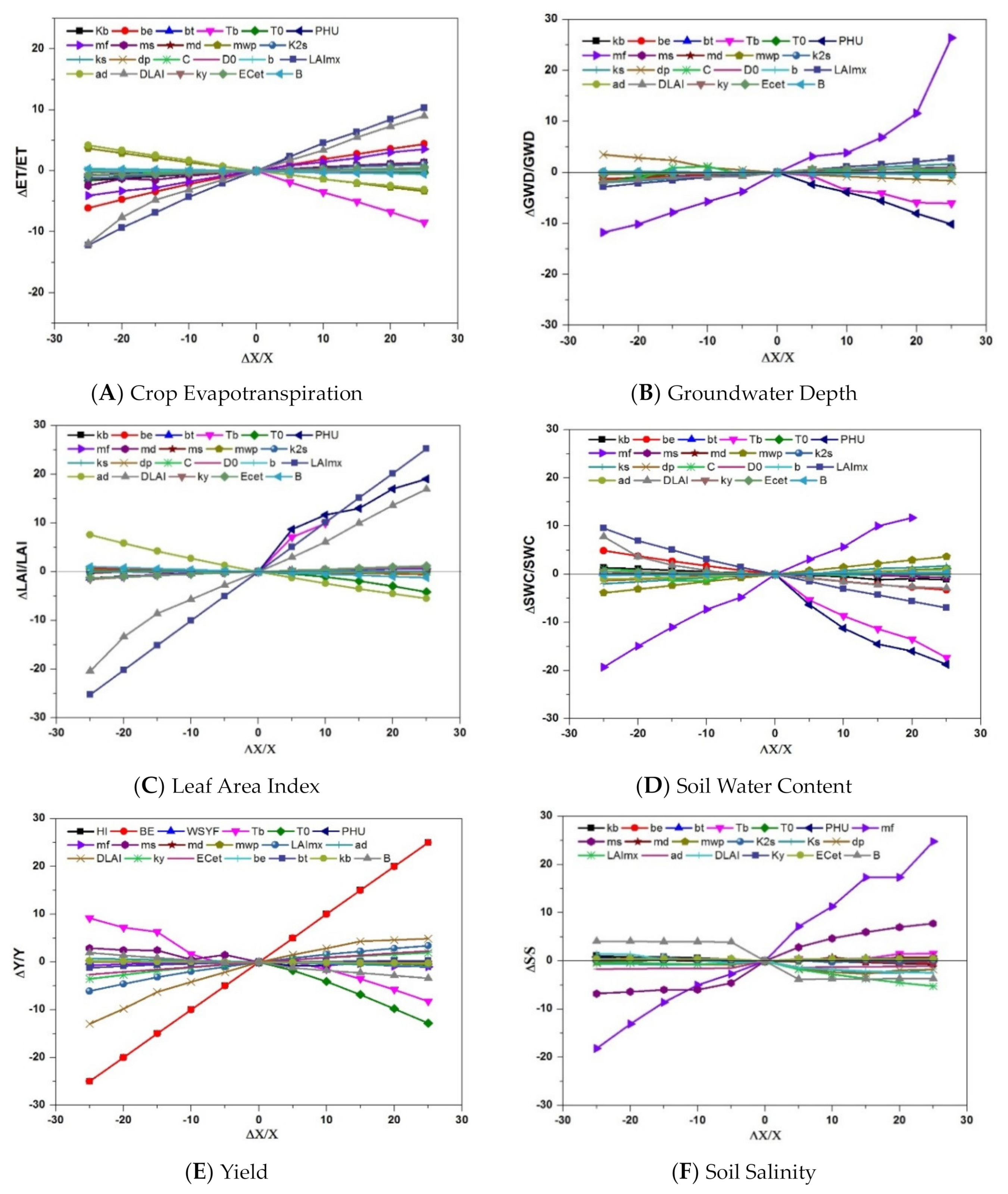
References
- Cai, L.G.; Mao, Z.; Fang, S.X.; Liu, H.S. The Yellow River basin and case study areas. In Water Saving in the Yellow River Basin: Issue and Decision Support Tools in Irrigation; Pereira, L.S., Cai, L.G., Musy, A., Minhas, P.S., Eds.; China Agricultural Press: Beijing, China, 2003; pp. 13–34. [Google Scholar]
- Li, C.; Yang, Z.; Wang, X. Trends of Annual Natural Runoff in the Yellow River Basin. Water Int. 2004, 29, 447–454. [Google Scholar] [CrossRef]
- Dalin, C.; Qiu, H.; Hanasaki, N.; Mauzerall, D.L.; Rodriguez-Iturbe, I. Balancing water resource conservation and food security in China. Proc. Natl. Acad. Sci. USA 2015, 112, 4588–4593. [Google Scholar] [CrossRef] [PubMed] [Green Version]
- Wang, H.; Liu, C.; Zhang, L. Water-saving agriculture in China: An overview. Adv. Agron. 2002, 75, 135–171. [Google Scholar] [CrossRef]
- Wang, X.Q.; Gao, Q.Z.; Lu, Q. Effective use of water resources, and salinity and waterlogging control in the Hetao Irrigation Area of Inner Mongolia. J. Arid Land Resour. Environ. 2005, 19, 118–123. [Google Scholar]
- Wei, C.; Ren, S.; Yang, P.; Wang, Y.; He, X.; Xu, Z.; Wei, R.; Wang, S.; Chi, Y.; Zhang, M. Effects of irrigation methods and salinity on CO2 emissions from farmland soil during growth and fallow periods. Sci. Total. Environ. 2020, 752, 141639. [Google Scholar] [CrossRef]
- Nie, S.; Bian, J.; Zhou, Y. Estimating the Spatial Distribution of Soil Salinity with Geographically Weighted Regression Kriging and Its Relationship to Groundwater in the Western Jilin Irrigation Area, Northeast China. Pol. J. Environ. Stud. 2020, 30, 283–294. [Google Scholar] [CrossRef]
- Yu, Y.; Li, X.; Zhao, C.; Zheng, N.; Jia, H.; Yao, H. Soil salinity changes the temperature sensitivity of soil carbon dioxide and nitrous oxide emissions. Catena 2020, 195, 104912. [Google Scholar] [CrossRef]
- Keesstra, S.; Mol, G.; De Leeuw, J.; Okx, J.; Molenaar, C.; De Cleen, M.; Visser, S. Soil-Related Sustainable Development Goals: Four Concepts to Make Land Degradation Neutrality and Restoration Work. Land 2018, 7, 133. [Google Scholar] [CrossRef] [Green Version]
- Hussain, M.; Ahmad, S.; Hussain, S.; Lal, R.; Ul-Allah, S.; Nawaz, A. Rice in Saline Soils: Physiology, Biochemistry, Genetics, and Management. Adv. Agron. 2018, 148, 231–287. [Google Scholar] [CrossRef]
- Farooq, M.; Hussain, M.; Wakeel, A.; Siddique, K.H.M. Salt stress in maize: Effects, resistance mechanisms, and management. A review. Agron. Sustain. Dev. 2015, 35, 461–481. [Google Scholar] [CrossRef] [Green Version]
- Visser, S.; Keesstra, S.; Maas, G.; De Cleen, M.; Molenaar, C. Soil as a Basis to Create Enabling Conditions for Transitions Towards Sustainable Land Management as a Key to Achieve the SDGs by 2030. Sustainability 2019, 11, 6792. [Google Scholar] [CrossRef] [Green Version]
- Keesstra, S.; Bouma, J.; Wallinga, J.; Tittonell, P.; Smith, P.; Cerdà, A.; Montanarella, L.; Quinton, J.N.; Pachepsky, Y.; Van Der Putten, W.H.; et al. The significance of soils and soil science towards realization of the United Nations Sustainable Development Goals. SOIL 2016, 2, 111–128. [Google Scholar] [CrossRef] [Green Version]
- Keesstra, S.; Geissen, V.; Mosse, K.; Piiranen, S.; Scudiero, E.; Leistra, M.; Van Schaik, L. Soil as a filter for groundwater quality. Curr. Opin. Environ. Sustain. 2012, 4, 507–516. [Google Scholar] [CrossRef]
- Gao, X.; Bai, Y.; Huo, Z.; Xu, X.; Huang, G.; Xia, Y.; Steenhuis, T.S. Deficit irrigation enhances contribution of shallow groundwater to crop water consumption in arid area. Agric. Water Manag. 2017, 185, 116–125. [Google Scholar] [CrossRef]
- Gao, X.Y.; Huo, Z.L.; Qu, Z.Y.; Bai, Y.N.; Huang, G.H.; Xu, X.; Huang, G.H.; Xia, Y.H.; Steenhuis, T.S. Modeling contribution of shallow groundwater to evapotranspiration and yield of maize in an arid irrigation district using readily available data. Sci. Rep. 2017, 7, 1–13. [Google Scholar]
- Termeh, S.V.R.; Khosravi, K.; Sartaj, M.; Keesstra, S.D.; Tsai, F.T.-C.; Dijksma, R.; Pham, B.T. Optimization of an adaptive neuro-fuzzy inference system for groundwater potential mapping. Hydrogeol. J. 2019, 27, 2511–2534. [Google Scholar] [CrossRef]
- Ragab, R.A.; El-Ghamry, W.M.; Amer, F. The Conjunctive Use of Rainfall and Shallow Water Table in Meeting Water Requirements of Faba Bean. J. Agron. Crop. Sci. 1988, 160, 47–53. [Google Scholar] [CrossRef]
- Khandker, M.H.K. Crop Growth and Water Use from Saline Water Tables. Ph.D. Thesis, University of Newcastle upon Tyne, Newcastle, UK, 1994; pp. 84–93. [Google Scholar]
- Ayars, J.; Schoneman, R.A. Irrigating field crops in the presence of saline groundwater. Irrig. Drain. 2006, 55, 265–279. [Google Scholar] [CrossRef]
- Gowing, J.; Rose, D.; Ghamarnia, H. The effect of salinity on water productivity of wheat under deficit irrigation above shallow groundwater. Agric. Water Manag. 2009, 96, 517–524. [Google Scholar] [CrossRef]
- Fan, Y.; Miguez-Macho, G. Potential groundwater contribution to Amazon evapotranspiration. Hydrol. Earth Syst. Sci. 2010, 14, 2039–2056. [Google Scholar] [CrossRef] [Green Version]
- Luo, Y.; Sophocleous, M. Seasonal groundwater contribution to crop-water use assessed with lysimeter observations and model simulations. J. Hydrol. 2010, 389, 325–335. [Google Scholar] [CrossRef]
- Gao, X.; Huo, Z.; Bai, Y.; Feng, S.; Huang, G.; Shi, H.; Qu, Z. Soil salt and groundwater change in flood irrigation field and uncultivated land: A case study based on 4-year field observations. Environ. Earth Sci. 2014, 73, 2127–2139. [Google Scholar] [CrossRef]
- Kahlown, M.; Ashraf, M.; Haq, Z.-U. Effect of shallow groundwater table on crop water requirements and crop yields. Agric. Water Manag. 2005, 76, 24–35. [Google Scholar] [CrossRef]
- Pan, Y.; Yuan, C.; Jing, S. Simulation and optimization of irrigation schedule for summer maize based on SWAP model in saline region. Int. J. Agric. Biol. Eng. 2020, 13, 117–122. [Google Scholar] [CrossRef]
- Silva, J.A.; Šimůnek, J.; McCray, J.E. A Modified HYDRUS Model for Simulating PFAS Transport in the Vadose Zone. Water 2020, 12, 2758. [Google Scholar] [CrossRef]
- Metternicht, G.; Zinck, J. Remote sensing of soil salinity: Potentials and constraints. Remote Sens. Environ. 2003, 85, 1–20. [Google Scholar] [CrossRef]
- Mejia, M.N.; Madramootoo, C.A.; Broughton, R.S. Influence of groundwater table management on corn and soybean yield. Agric. Water Manag. 2000, 46, 73–89. [Google Scholar] [CrossRef]
- Wang, Q.J.; Wang, W.Y.; Lu, D.Q.; Wang, Z.R.; Zhang, J.F. Water and salt transport features for salt-effected soil through drip irrigation under film. Trans. Chin. Soc. Agric. Eng. 2000, 16, 54–57. [Google Scholar]
- Huo, Z.; Feng, S.; Huang, G.; Zheng, Y.; Wang, Y.; Guo, P. Effect of groundwater level depth and irrigation amount on water fluxes at the groundwater table and water use of wheat. Irrig. Drain. 2011, 61, 348–356. [Google Scholar] [CrossRef]
- Scanlon, B.R.; Healy, R.W.; Cook, P.G. Choosing appropriate techniques for quantifying groundwater recharge. Hydrogeol. J. 2002, 10, 18–39. [Google Scholar] [CrossRef]
- Kendy, E.; Gérard-Marchant, P.; Walter, M.T.; Zhang, Y.; Liu, C.; Steenhuis, T.S. A soil-water-balance approach to quantify groundwater recharge from irrigated cropland in the North China Plain. Hydrol. Process. 2003, 17, 2011–2031. [Google Scholar] [CrossRef]
- Yang, J.; Wan, S.; Deng, W.; Zhang, G. Water fluxes at a fluctuating water table and groundwater contributions to wheat water use in the lower Yellow River flood plain, China. Hydrol. Process. 2007, 21, 717–724. [Google Scholar] [CrossRef]
- Simunek, J.; Van Genuchten, M.; Sejia, M. The HYDRUS-1D Software Package for Simulating the One-Dimensional Movement of Water, Heat and Multiple Solutes in Variability-Saturated Media. Hydrus Softw. 2005, 68. Available online: https://www.pc-progress.com/Downloads/Pgm_hydrus1D/HYDRUS1D-4.08.pdf (accessed on 14 December 2020).
- Prathapar, S.A.; Qureshi, A.S. Modelling the Effects of Deficit Irrigation on Soil Salinity, Depth to Water Table and Transpiration in Semi-arid Zones with Monsoonal Rains. Int. J. Water Resour. Dev. 1999, 15, 141–159. [Google Scholar] [CrossRef]
- Healy, R.W.; Cook, P.G. Using groundwater levels to estimate recharge. Hydrogeol. J. 2002, 10, 91–109. [Google Scholar] [CrossRef]
- Ayars, J.; Christen, E.W.; Soppe, R.W.; Meyer, W.S. The resource potential of in-situ shallow ground water use in irrigated agriculture: A review. Irrig. Sci. 2005, 24, 147–160. [Google Scholar] [CrossRef]
- Gao, X.Y. Modeling Agricultural Water Productivity in Shallow Groundwater Area. Ph.D. Thesis, China Agricultural University, Beijing, China, 2017. [Google Scholar]
- Wit, K. Apparatus for Measuring Hydraulic Conductivity of Undisturbed Soil Samples. Permeability Capillarity Soils 2009, 72. [Google Scholar] [CrossRef]
- Valdes, R.; Miralles, J.; Franco, J.; Sánchez-Blanco, M.; Banon, S. Using soil bulk electrical conductivity to manage saline irrigation in the production of potted poinsettia. Sci. Hortic. 2014, 170, 1–7. [Google Scholar] [CrossRef]
- Leao, T.P.; Perfect, E.; Tyner, J.S. New semi-empirical formulae for predicting soil solution conductivity from dielectric properties at 50MHz. J. Hydrol. 2010, 393, 321–330. [Google Scholar] [CrossRef]
- Williams, J.R. The EPIC Model. Computer Models of Watershed Hydrology. 909–1000; Singh, V.P., Ed.; Water Resources Publications: Highland Ranch, CO, USA, 1995. [Google Scholar]
- Saleh, A.F.M.; Steenhuis, T.S.; Walter, M.F. Groundwater Table Simulation under Different Rice Irrigation Practices. J. Irrig. Drain. Eng. 1989, 115, 530–544. [Google Scholar] [CrossRef]
- Wang, X.C.; Li, J. Evaluation of crop yield and soil water estimates using the EPIC model for the Loess Plateau of China. Math. Comput. Model. 2010, 51, 1390–1397. [Google Scholar] [CrossRef]
- Gardner, W.R. Some steady-state solutions of the unsaturated moisture flow equation with application to evaporation from a water table. Soil Sci. 1958, 85, 228–232. [Google Scholar] [CrossRef]
- Williams, J.R.; Wang, E.; Meinardus, A.; Harman, W.L.; Siemers, M.; Atwood, J.D. EPIC Users Guide v. 0509; Blackland Research and Extension Center: Temple, TX, USA, 2006. [Google Scholar]
- Xu, X.; Sun, C.; Qu, Z.; Huang, Q.; Ramos, T.B.; Huang, G. Groundwater Recharge and Capillary Rise in Irrigated Areas of the Upper Yellow River Basin Assessed by an Agro-Hydrological Model. Irrig. Drain. 2015, 64, 587–599. [Google Scholar] [CrossRef]
- Moriasi, D.N.; Arnold, J.G.; Van Liew, M.W.; Bingner, R.L.; Harmel, R.D.; Veith, T.L. Model Evaluation Guidelines for Systematic Quantification of Accuracy in Watershed Simulations. Trans. ASABE 2007, 50, 885–900. [Google Scholar] [CrossRef]
- Abbaspour, K.C.; Johnson, A.; van Genuchten, M.T. Estimating uncertain flow and transport parameters using a sequential uncertainty fitting procedure. Vadose Zone J. 2004, 3, 1340–1350. [Google Scholar] [CrossRef]
- Talebizadeh, M.; Moridnejad, A. Uncertainty analysis for the forecast of lake level fluctuations using ensembles of ANN and ANFIS models. Expert Syst. Appl. 2011, 38, 4126–4135. [Google Scholar] [CrossRef]
- Jiang, J.; Feng, S.-Y.; Sun, Z.; Huo, Z. Effects of non-sufficient irrigation with saline water on soil water-salt distribution and spring corn yield. Ying Yong Sheng Tai Xue Bao J. Appl. Ecol. 2008, 19, 2637–2642. [Google Scholar]
- Masoud, M.; Schumann, S.; Mogheeth, S.A. Estimation of groundwater recharge in arid, data scarce regions; an approach as applied in the EI Hawashyia basin and Ghazala sub-basin (Gulf of Suez, Egypt). Environ. Earth Sci. 2013, 69, 103–117. [Google Scholar] [CrossRef]
- Babajimopoulos, C.; Panoras, A.; Georgoussis, H.; Arampatzis, G.; Hatzigiannakis, E.; Papamichail, D. Contribution to irrigation from shallow water table under field conditions. Agric. Water Manag. 2007, 92, 205–210. [Google Scholar] [CrossRef]
- Sun, H.-Y.; Liu, C.-M.; Zhang, X.-Y.; Shen, Y.-J.; Zhang, Y.-Q. Effects of irrigation on water balance, yield and WUE of winter wheat in the North China Plain. Agric. Water Manag. 2006, 85, 211–218. [Google Scholar] [CrossRef]
- Narany, T.S.; Aris, A.Z.; Sefie, A.; Keesstra, S. Detecting and predicting the impact of land use changes on groundwater quality, a case study in Northern Kelantan, Malaysia. Sci. Total. Environ. 2017, 599, 844–853. [Google Scholar] [CrossRef] [PubMed]
- Keesstra, S.; Kondrlovà, E.; Czajka, A.; Seeger, M.; Maroulis, J. Assessing riparian zone impacts on water and sediment movement: A new approach. Neth. J. Geosci. 2012, 91, 245–255. [Google Scholar] [CrossRef]
- Mueller, L.; Behrendt, A.; Schalitz, G.; Schindler, U. Above ground biomass and water use efficiency of crops at shallow groundwater tables in a temperate climate. Agric. Water Manag. 2005, 75, 117–136. [Google Scholar] [CrossRef]
- Steenhuis, T.S.; Van Der Molen, W.H. The Thornthwaite-mather procedure as a simple engineering method to predict recharge. J. Hydrol. 1985, 84, 221–229. [Google Scholar] [CrossRef]
- Saxton, K.E.; Rawls, W.J.; Romberger, J.S. Estimating generalized soil-water characteristics. Soil Sci. Soc. Am. J. 1986, 50, 1301–1306. [Google Scholar] [CrossRef]
- Campbell, G.S.; Norman, J.M. An Introduction to Environmental Biophysics, 2nd ed.; Springer: New York, NY, USA, 1998; p. 249. [Google Scholar]
- Stockle, C.O. Simulation of the Effect of Water and Nitrogen Stress on Growth and Yield of Spring Wheat. Ph.D. Dissertation, Washington State University, Pullman, WA, USA, 1985. [Google Scholar]
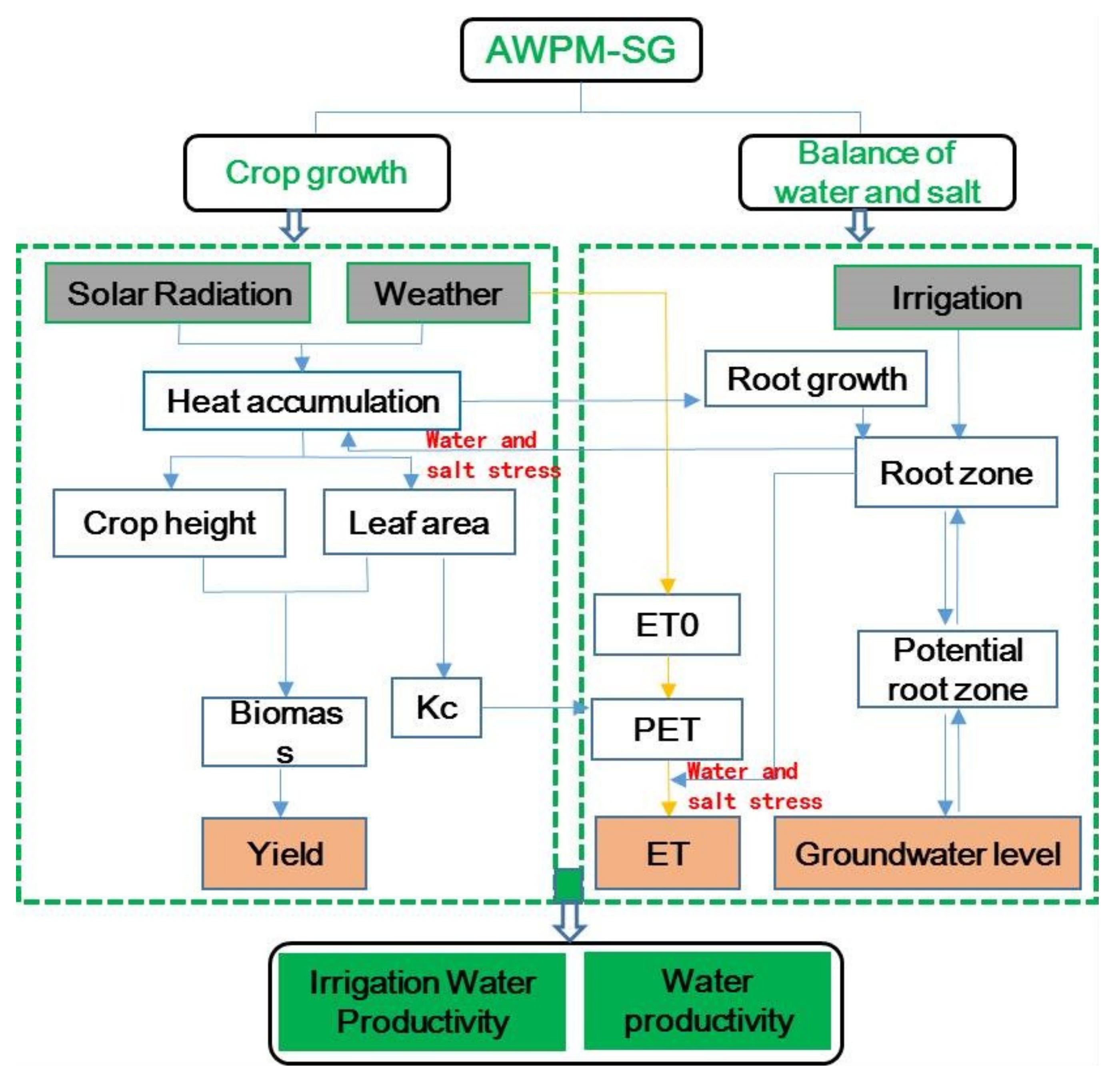
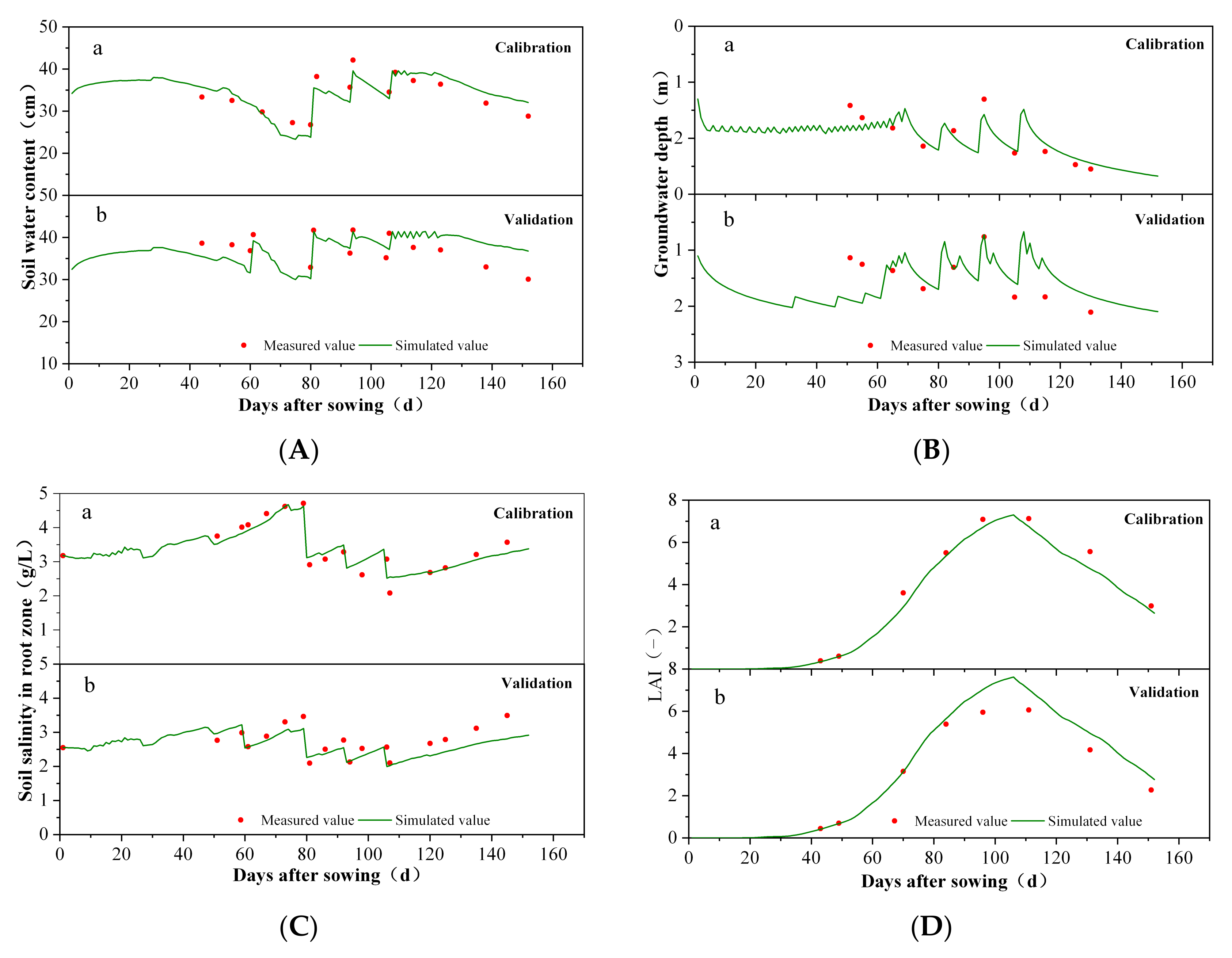
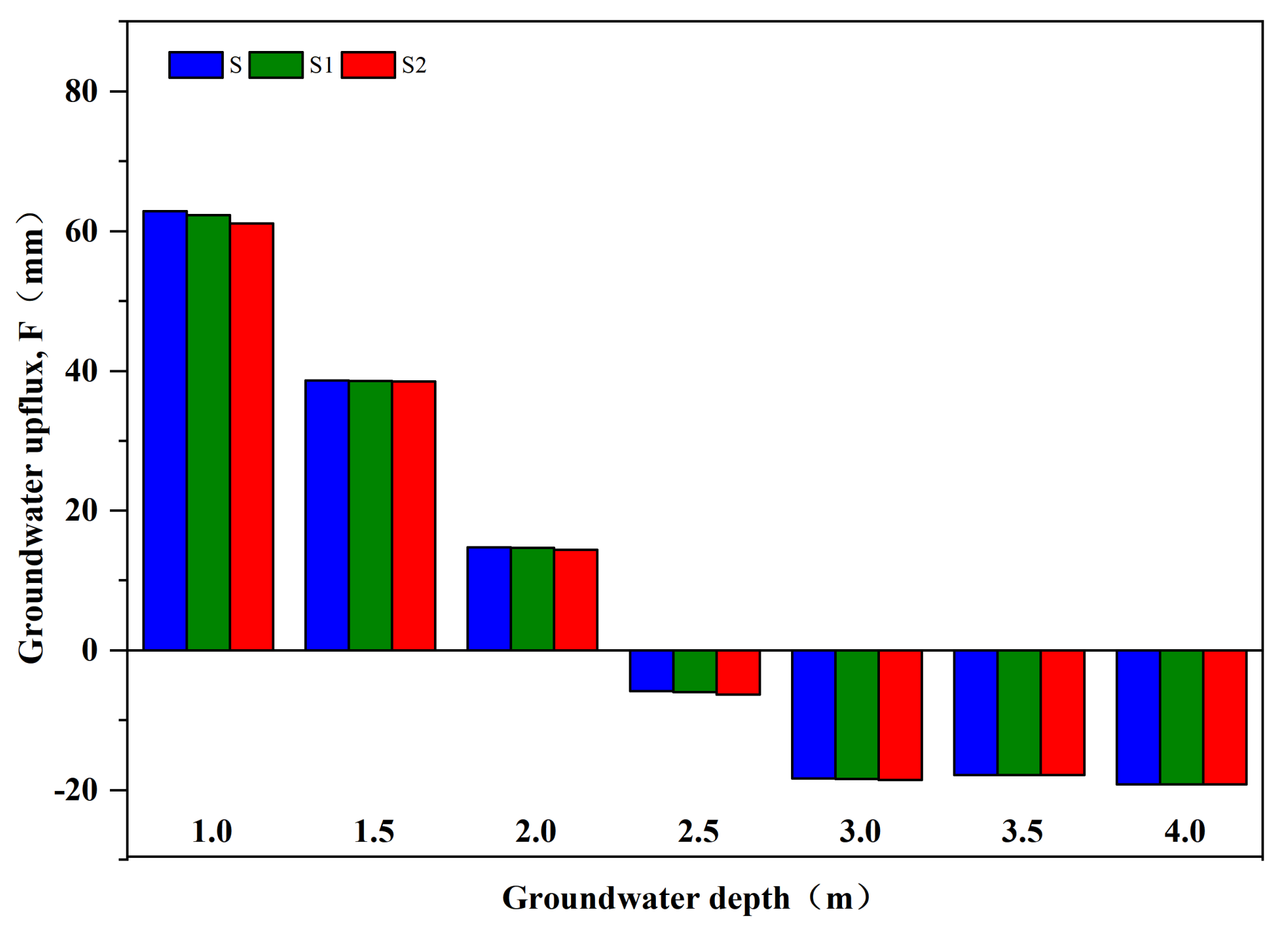

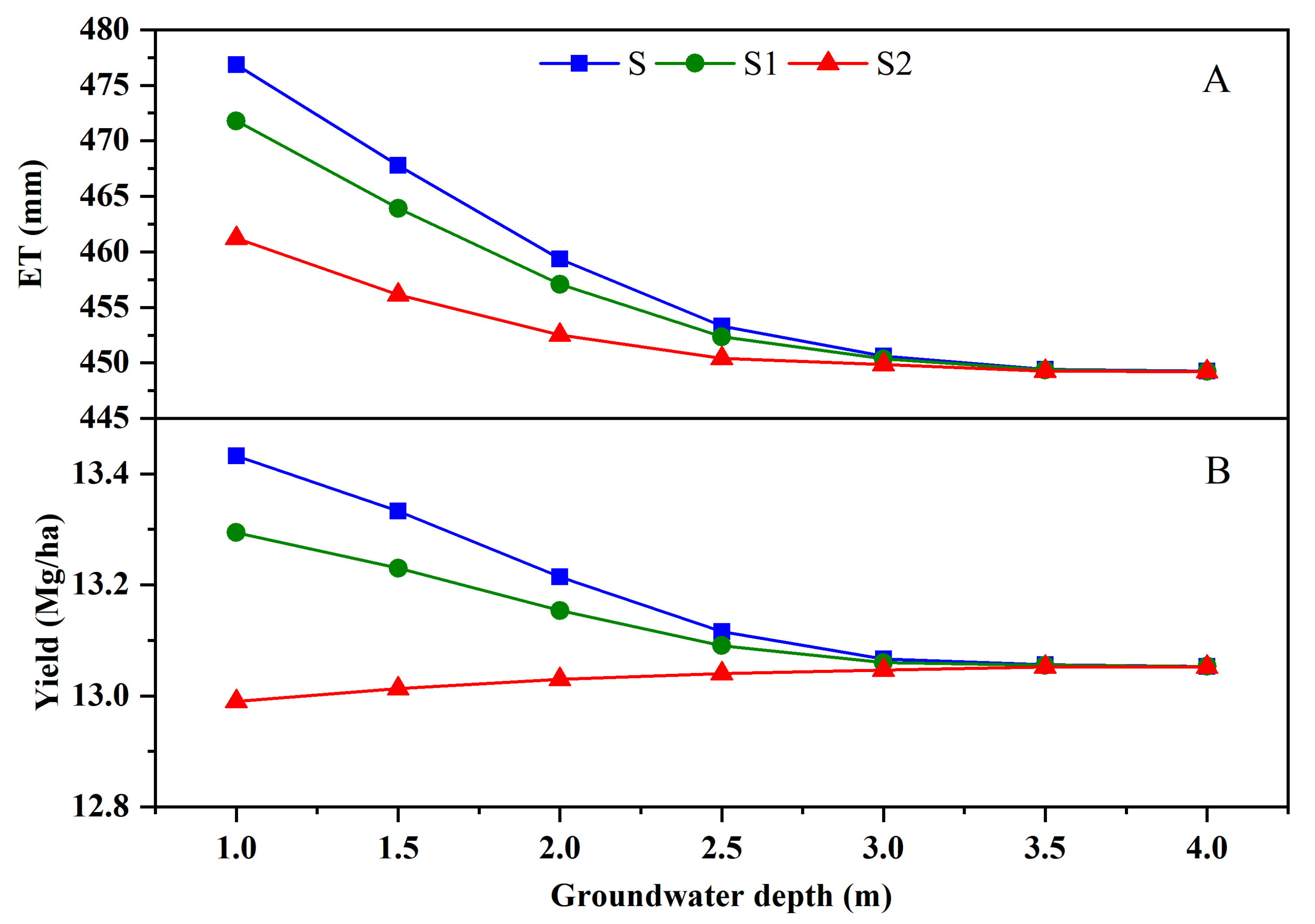
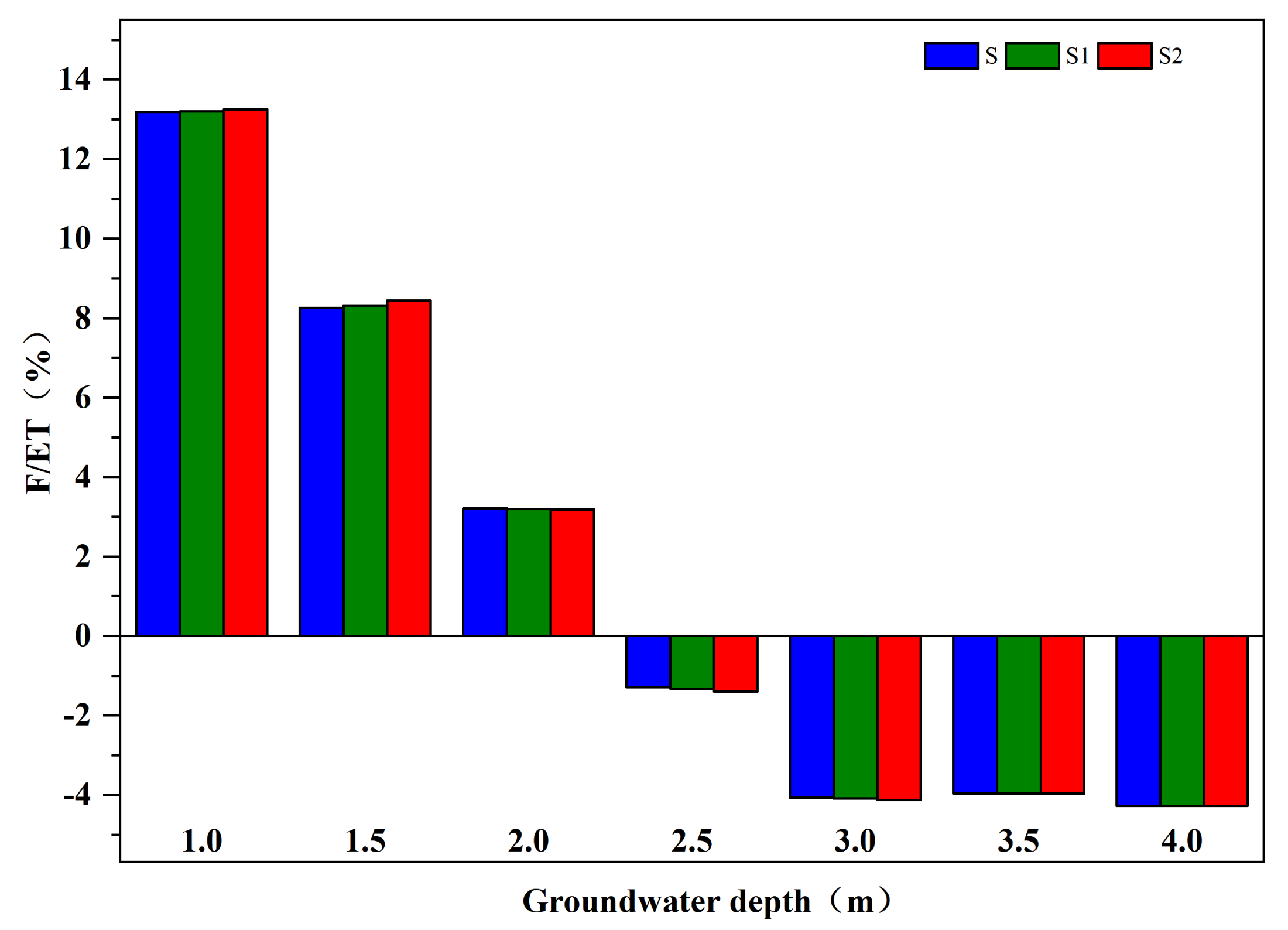
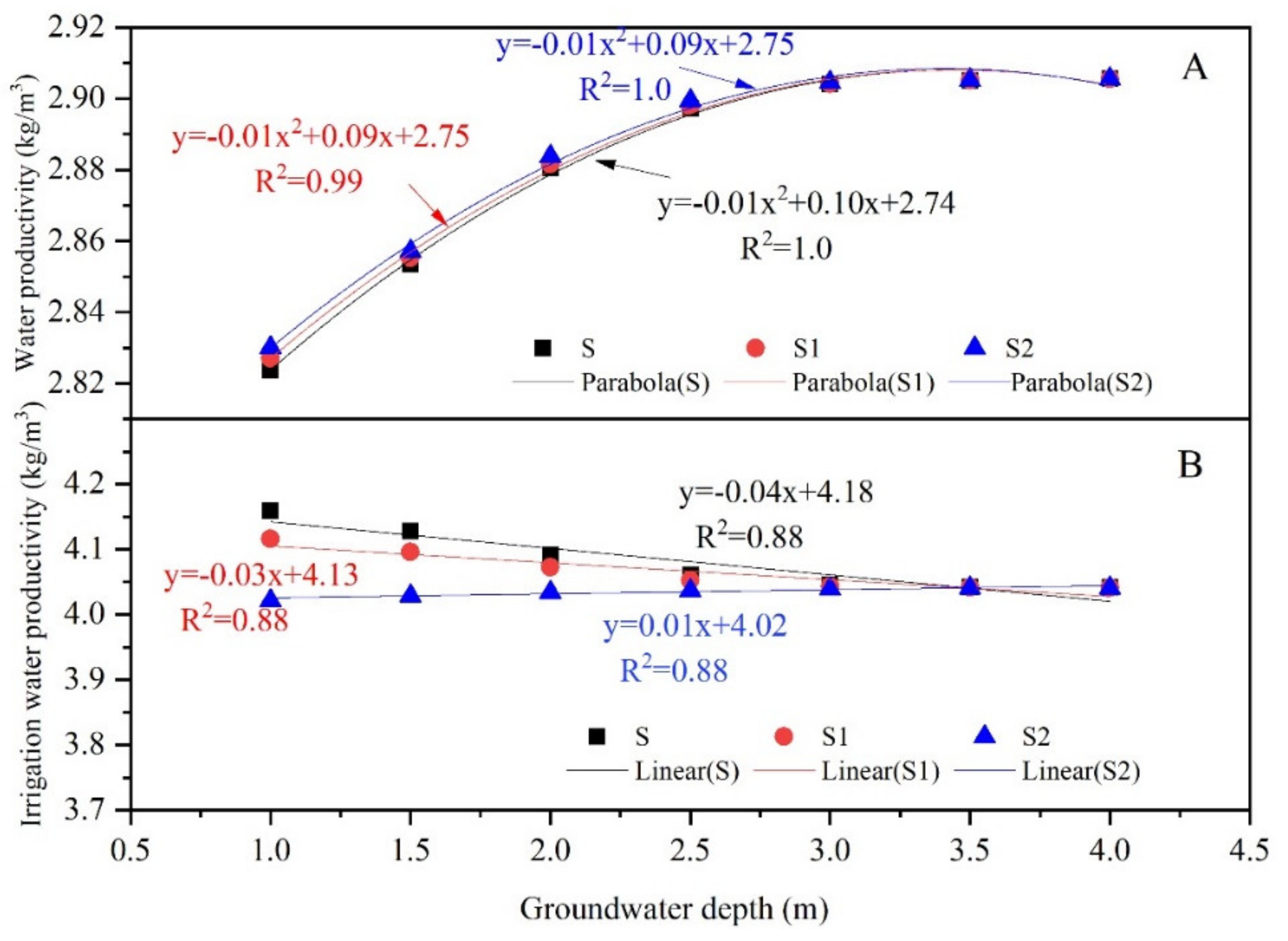
| Crop | Date | Irrigation Amount (mm) | |
|---|---|---|---|
| F1 | F2 | ||
| Maize | 7/13 | 114.91 | 118.84 |
| Maize | 7/26 | 86.11 | 86.11 |
| Maize | 8/8 | 122.04 | 122.04 |
| Soil Depths (cm) | Soil Particle Size Distribution | Soil Texture | Bulk Density (g/cm3) | Field Capacity,mf (cm3/cm3) | Wilting Point (cm3/cm3) | ||
|---|---|---|---|---|---|---|---|
| Clay (<0.002 mm) | Silt (0.002–0.05 mm) | Sand (0.05–2.0 mm) | |||||
| 0–90 | 15 | 75.14 | 9.86 | Silty loam | 1.41 | 0.32 | 0.04 |
| 90–150 | 4.01 | 56.56 | 39.43 | Silty loam | 1.45 | 0.30 | 0.06 |
| Depth (cm) | Soil Typer | ms | md | ks | C | dp | D0 | b |
|---|---|---|---|---|---|---|---|---|
| (cm3/cm3) | (cm3/cm3) | (cm/d) | ||||||
| Initial values | ||||||||
| 0–90 | Sandy loam | 0.395 | 0.07 | 30 | 8 | 0.58 | 35.2 | |
| 90–150 | Sandy loam | 0.45 | 0.07 | 80 | 0.08 | |||
| Calibrated values | ||||||||
| 0–90 | Sandy loam | 0.43 | 0.08 | 30 | 13 | 0.1 | 17.5 | |
| 90–150 | Sandy loam | 0.56 | 0.08 | 86 | 0.08 |
| Parameters | Default Values | Calibrated Values |
|---|---|---|
| Dimensionless canopy, kb | 0.5 | 0.8 |
| be | 0.3 | 0.5 |
| bt | 4 | 4 |
| Minimun temperature for plant growth, Tb (°C) | 8 | 8 |
| Optimal temperature for plant growth, T0 (°C) | 25 | 25 |
| Leaf area index decline rate, ad | 1.0 | 0.75 |
| Maximum crop height, hmx (cm) | 250 | 340 |
| Maximum leaf area index, LAImx | 6.0 | 8.2 |
| Maximum root depth, RDmx (cm) | 90 | 90 |
| Plant radiation-use efficienc, BE ((kg×)/(MJ×)) | 40 | 40 |
| Harvest index, HI | 0.5 | 0.4 |
| Total potential heat units required for crop maturation, PHU (℃) | 2000 | 2100 |
| A parameter expressing the sensitivity of harvest index to drought, WYSF | 0.05 | 0.05 |
| reduction in yield per increase in ECe (%/(ms cm−1)) | 12 | 12 |
| electrical conductivity of the saturation extract at the threshold of ECe when crop yield first reduces below Ym (ms cm−1) | 1.7 | 1.7 |
| a yield response factor | 1.25 | 1.25 |
| Root Mean Square Error, RMSE | Nash and Sutcliffe Model Efficiency, NSE | Mean Relative Error, MRE (%) | Coefficient of Determination, R2 | Regression Coefficient, b | ||
|---|---|---|---|---|---|---|
| Calibration | Soil water content (cm) | 2.66 | 0.49 | −1.07 | 0.99 | 0.99 |
| Soil salinity (g/L) | 0.26 | 0.85 | −2.57 | 0.90 | 0.96 | |
| Groundwater depth (m) | 0.2 | 0.56 | 0.85 | 0.57 | 0.99 | |
| LAI | 0.42 | 0.97 | −8.4 | 0.99 | 0.93 | |
| Validation | Soil water content (cm) | 1.56 | 0.28 | 1.61 | 1 | 1.01 |
| Soil salinity (g/L) | 0.34 | 0.17 | −7.12 | 0.57 | 0.92 | |
| Groundwater depth (m) | 0.33 | −0.02 | −2.63 | 0.19 | 0.92 | |
| LAI | 0.82 | 0.85 | 14.03 | 0.95 | 1.15 |
| d-Factor | Parameter | ||||||||||
|---|---|---|---|---|---|---|---|---|---|---|---|
| mf | ms | md | mwp | k2s | ks | C | D0 | b | dp | LAImx | |
| Groundwater depth | 1.44 | 0.38 | 0.03 | 0.006 | 0.07 | 0.2 | 0.15 | 0 | 0.002 | 0.18 | 0.2 |
| LAI | 0.006 | 0.002 | 0 | 0.003 | 0 | 0 | 0 | 0 | 0 | 0 | 0.56 |
| Soil water content | 0.72 | 0.28 | 0.02 | 0.07 | 0.07 | 0.12 | 0.11 | 0 | 0.001 | 0.06 | 0.29 |
| Soil salinity | 1.62 | 1.25 | 0.25 | 0.15 | 0.32 | 0.45 | 0 | 0 | 0 | 0.55 | 0.38 |
| ad | DLAI | Tb | T0 | kb | be | bt | PHU | Ky | ECet | B | |
| Groundwater depth | 0 | 0.09 | 0.38 | 0.07 | 0.03 | 0.08 | 0.008 | 0.45 | 0.053 | 0.052 | 0.03 |
| LAI | 0.11 | 0.46 | 0.29 | 0.19 | 0 | 0.003 | 0.008 | 0.39 | 0 | 0 | 0 |
| Soil water content | 0.04 | 0.15 | 0.14 | 0.03 | 0.06 | 0.11 | 0.01 | 0.18 | 0.005 | 0.006 | 0.01 |
Publisher’s Note: MDPI stays neutral with regard to jurisdictional claims in published maps and institutional affiliations. |
© 2020 by the authors. Licensee MDPI, Basel, Switzerland. This article is an open access article distributed under the terms and conditions of the Creative Commons Attribution (CC BY) license (http://creativecommons.org/licenses/by/4.0/).
Share and Cite
Gao, X.; Qu, Z.; Huo, Z.; Tang, P.; Qiao, S. Understanding the Role of Shallow Groundwater in Improving Field Water Productivity in Arid Areas. Water 2020, 12, 3519. https://doi.org/10.3390/w12123519
Gao X, Qu Z, Huo Z, Tang P, Qiao S. Understanding the Role of Shallow Groundwater in Improving Field Water Productivity in Arid Areas. Water. 2020; 12(12):3519. https://doi.org/10.3390/w12123519
Chicago/Turabian StyleGao, Xiaoyu, Zhongyi Qu, Zailin Huo, Pengcheng Tang, and Shuaishuai Qiao. 2020. "Understanding the Role of Shallow Groundwater in Improving Field Water Productivity in Arid Areas" Water 12, no. 12: 3519. https://doi.org/10.3390/w12123519
APA StyleGao, X., Qu, Z., Huo, Z., Tang, P., & Qiao, S. (2020). Understanding the Role of Shallow Groundwater in Improving Field Water Productivity in Arid Areas. Water, 12(12), 3519. https://doi.org/10.3390/w12123519





